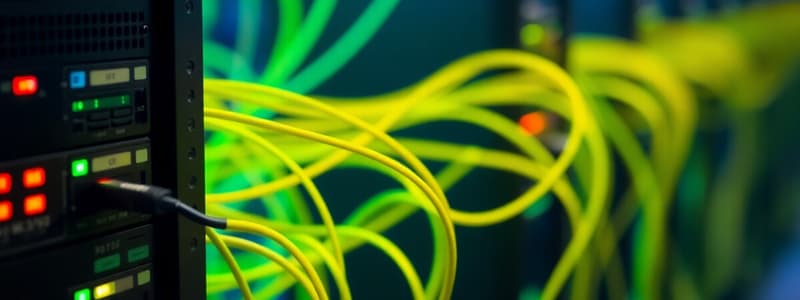Podcast
Questions and Answers
What is the role of the Digital Subscriber Line Access Multiplexer (DSLAM) in a broadband network?
What is the role of the Digital Subscriber Line Access Multiplexer (DSLAM) in a broadband network?
The DSLAM handles traffic from multiple customer connections and routes it onto a single high-speed connection to the Internet.
How does the Asynchronous Transfer Mode (ATM) switch function within a broadband telecommunication network?
How does the Asynchronous Transfer Mode (ATM) switch function within a broadband telecommunication network?
The ATM switch acts as a local exchange switch that allows connections to the Public Switched Telephone Network (PSTN) for telephone access.
What types of customers does the central office (CO) typically serve in a broadband network?
What types of customers does the central office (CO) typically serve in a broadband network?
The central office serves both residential and business customers.
What purpose does a proxy server serve in a business's internal network?
What purpose does a proxy server serve in a business's internal network?
Describe the function of an ADSL bridge in a broadband network.
Describe the function of an ADSL bridge in a broadband network.
What are the three distinct blocks that make up the basic broadband cable network architecture?
What are the three distinct blocks that make up the basic broadband cable network architecture?
What is the primary function of an Internet Service Provider (ISP) in a broadband network?
What is the primary function of an Internet Service Provider (ISP) in a broadband network?
How do residential and business broadband customers differ in terms of network access equipment?
How do residential and business broadband customers differ in terms of network access equipment?
What role does coaxial cable play in broadband communication?
What role does coaxial cable play in broadband communication?
How does videoconferencing enhance patient care in the healthcare industry?
How does videoconferencing enhance patient care in the healthcare industry?
What is internetworking and why is it important?
What is internetworking and why is it important?
Name three devices used for interconnecting broadband networks.
Name three devices used for interconnecting broadband networks.
What is DTMF and its significance in internetworking protocols?
What is DTMF and its significance in internetworking protocols?
Why are standards crucial in broadband communication systems?
Why are standards crucial in broadband communication systems?
List two organizations responsible for setting communication standards.
List two organizations responsible for setting communication standards.
What types of speeds do most internetworks utilize for data transfer?
What types of speeds do most internetworks utilize for data transfer?
Study Notes
Broadband Communication Systems
- Broadband communication systems utilize a central office (CO) to connect various network components such as the digital subscriber line access multiplexer (DSLAM), asynchronous transfer mode (ATM) switch, and internet service provider (ISP).
- DSLAM handles all user traffic and aggregates it onto a single high-speed connection to the internet.
- ATM switch connects to the public switched telephone network (PSTN) for telephone access.
- The ISP is the company that provides internet services to customers.
Broadband Network Architecture
- A typical office network uses a proxy server as a secure access point between the business user and the internet.
- The proxy server acts as a firewall, providing security and administrative control along with caching services for the local area network (LAN).
- An ADSL bridge connects the business LAN to another LAN using the same network protocol, and separates telephone and internet usage for the user.
Cable Broadband Network Architecture
- The basic cable broadband network architecture consists of three main blocks: regional cable headend, distribution hub, and fiber node (or local distributor).
- Coaxial cable is usually used from the distribution hub to connect customer premises.
Importance of Broadband Communication
- One prominent application of broadband communication is videoconferencing in healthcare.
- Videoconferencing enables specialists to remotely attend to critical patients, saving time and resources.
- Broadband networks are the only means of achieving innovative applications that require integration of data, voice, and video.
Internetworking
- Internetworking involves connecting two or more computer networks using devices such as bridges, WAN switches, routers, and gateways.
- Most internetworks use telecommunication facilities with data transfer speeds ranging from 19.2 kbps to 56 kbps, along with faster options like digital T1 (1.544 Mbps) and T3 (44.736 Mbps).
- A signaling mechanism called DTMF (dual tone multi-frequency) is used in internetworking broadband systems.
Standards
- Standards are crucial for ensuring compatibility and interoperability within broadband communication systems.
- Numerous standards organizations contribute to the development of these standards, such as the International Standards Organization (ISO), Institute of Electrical and Electronics Engineers (IEEE), United States ANSI Committee on Telecommunications, Telecommunications Industry Association (TIA), Japanese Telecommunications Technology Committee (TTC), European Telecommunications Standards Institute (ETSI), and International Telecommunications Union (ITU).
Studying That Suits You
Use AI to generate personalized quizzes and flashcards to suit your learning preferences.
Related Documents
Description
This quiz covers the essentials of broadband communication systems, including key components like DSLAM, ATM switches, and ISPs. Additionally, it explores the architecture of broadband networks, focusing on the role of proxy servers and ADSL bridges. Test your understanding of how these systems operate and their significance in connecting users to the internet.



